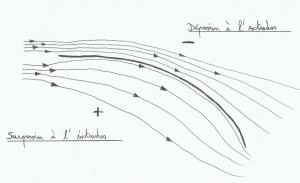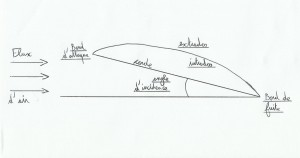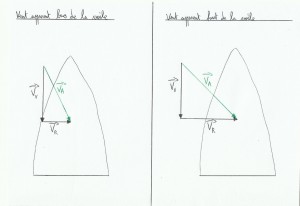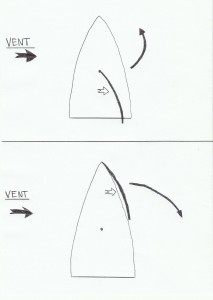In the article aero / hydro, we have seen that a boat works with apparent's wind, addition of the speed wind caused by the ship movement and the true wind. However a question comes quickly: how a sailing boat can go ahead against the wind?
1)Bernoulli
Physician by his studies, Bernoulli has created a capillary tube able to measure blood pressure. By inserting it into a blood vessel belonging to a living(beuark!)he has noticed that blood circulation in an artery was depending on pressure differences along it. Basically the more vessel's diameter is smaller the more blood speed increases, for a vessel twice less large blood circulates four times faster(the square of width reduction). He has just found an equation able to include speed and pressure parameters in a moving fluid, it also explains plane flights. The fast fluid movement creates a vacuum which causes the lift to the aircraft wing or the sail of a boat thanks to its shape.
The wind flow passing on the intrados wins a space surplus with the sail's shape(flow lines deviate), less air flows through more space. it will therefore create an air slowdown relative to the main air flow(static pressure increases).
Flux lines on extrados are deflected outwardly with the sail's shape, however, they can not push and compress the adjacent lines continuously. These lines are tightened near the sail's convex side on extrados, and set up a small depression in the air stream which attracts the sail, Nature hates vacuum in general(the dynamic pressure increases).
Notice: Bernoulli's rule is also expressed in this way: static pressure + dynamic pressure =constant.
At fair points of sailing like broad reach sails work only with air push, air flow on the extrados surface are then turbulent(it forms whirls).
The apparent wind is different between the foot and top of a sail, it veers aft with elevation because the true wind undergoes less friction when he is higher. The sail's twist is therefore essential to keep the apparent wind tangent to the leading edge. the twist brings an equal angle of incidence on the sail's height but the angle between "la corde"(see the little draw above, I 'm sorry don't know the English word)and the boat's lubber line increases when we climb higher in the sail's height.
2)genoa and mainsail
As we have just seen, immersing a profile in a moving fluid(or a moving profile in a fluid)influences the fluid's flow(here, the wind). On a boat with two sails, we will therefore have a different apparent wind for each of them; because of the mainsail the apparent wind veers aft for the genoa, with the presence of the genoa, the apparent wind heads for the mainsail. In fact the mainsail will always be more trimmed on close to the lubber line than the genoa(a laser boat, a sportive dinghy rigged with just one sail will be adjusted more open than a cruising boat's mainsail in the same conditions for exemple). This also explains that the more a boat uses sails in the same time(schooner, ketch…)the more his close-hauled heading will be far from the wind because sails undergo each other .
Another thing: genoas with high covering(long foot)masks the luff of mainsails, that's why we can often notice close-hauled on that kind of boat the mainsail's luff flapping “aback”.
Sailing boat turns around its keel, it is important to keep in mind this idea: a mainsail makes a boat luff, a headsail makes a boat bear away. it's useful to know that to have a balanced boat under sails, and also during maneuvers under just one sail. For example trying to make a tack with just the headsail is useless, and a boat under its mainsail only will be more efficient to get closer to the wind than a boat under its headsail only(the headsail alone also has advantages, this sail handles more easily, faster to drop and this at all the points of sailing).



